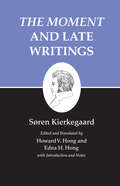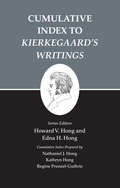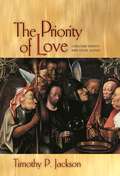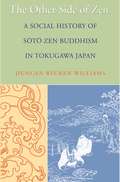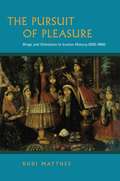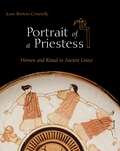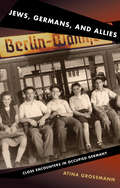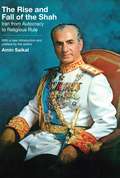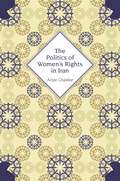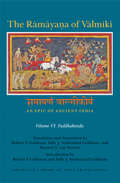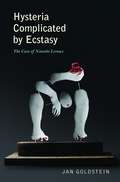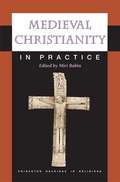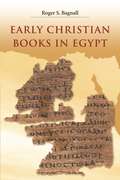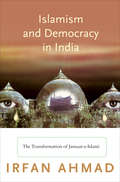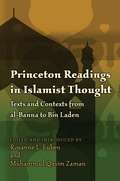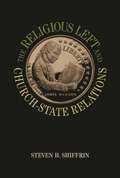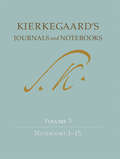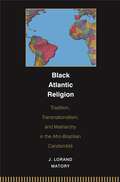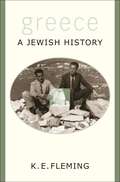- Table View
- List View
Kierkegaard's Writings, XXIII, Volume 23: "The Moment" and Late Writings
by Søren Kierkegaard Howard V. Hong Edna H. HongKierkegaard, a poet of ideals and practitioner of the indirect method, also had a direct and polemical side. He revealed this in several writings throughout his career, culminating in The Moment, his attack against the established ecclesiastical order. Kierkegaard was moved to criticize the church by his differences with Bishop Mynster, Primate of the Church of Denmark. Although Mynster saw in Kierkegaard a complement to himself and his outlook, Kierkegaard challenged Mynster to acknowledge the emptying and estheticizing of Christianity that had occurred in modern Christendom. For three years Kierkegaard was silent, waiting. When Mynster died, he was memorialized as "an authentic truth-witness" in the "holy chain of truth-witnesses that stretches through the ages from the days of the apostles." This struck Kierkegaard as blasphemous and inspired him to write a series of articles in Fædrelandet, which he followed with ten numbers of the pamphlet The Moment. This volume includes the articles from Fædrelandet, all numbers of The Moment, and several other late pieces of Kierkegaard's writing.
Kierkegaard's Writings, XXVI, Volume 26: Cumulative Index to "Kierkegaard`s Writings"
by Howard V. Hong Edna H. Hong Nathaniel J. Hong Kathryn Hong Regine Prenzel-GuthrieThe final volume of Princeton's Kierkegaard's Writings series, the Cumulative Index provides wide-ranging navigation to the preceding twenty-five volumes. Composed of over 90,000 entries, the Cumulative Index offers access to Kierkegaard's complex authorship and the extraordinary range of subjects he addressed in his writing. Covering the series' historical introductions, primary works, supplementary material (journal entries), and footnotes, the Cumulative Index provides a comprehensive entryway to more than 11,000 pages of text. Readers are able to survey via extended entries Kierkegaard's dual authorship, pseudonymous and signed; his numerous biblical allusions; his references to Christianity, God, and love; and his frequent use of analogies. A cumulative collation of the extensive supplementary material is also included, giving researchers and avid readers the opportunity to cross-reference Kierkegaard's Writings with his journals and papers published elsewhere in both English and Danish.
The Priority of Love: Christian Charity and Social Justice (New Forum Books #57)
by Timothy P. JacksonThis book explores the relation between agape (or Christian charity) and social justice. Timothy Jackson defines agape as the central virtue in Christian ethical thought and action and applies his insights to three concrete issues: political violence, forgiveness, and abortion. Taking his primary cue from the New Testament while drawing extensively from contemporary theology and philosophy, Jackson identifies three features of Christian charity: unconditional commitment to the good of others, equal regard for others' well-being, and passionate service open to self-sacrifice for the sake of others.Charity, prescribed by Jesus for his disciples and named by Saint Paul as the "greatest" theological virtue, is contrasted with various accounts of justice. Jackson argues that agape is not trumped by justice or other goods. Rather, agape precedes justice: without the work of love, society would not produce persons capable of merit, demerit, and contract, the elements of most modern conceptions of justice. Jackson then considers the implications of his ideas for several questions: the nature of God, the relation between Christian love and political violence, the place of forgiveness, and the morality of abortion. Arguing that agapic love is to be construed as a gift of grace as well as a divine commandment, Jackson concludes that love is the "eternal life" that makes temporal existence possible and thus the "first" Christian virtue. Though foremost a contribution to Christian ethics, Jackson's arguments and the issues he takes up will find a broader readership.
The Other Side of Zen: A Social History of Sōtō Zen Buddhism in Tokugawa Japan (Buddhisms: A Princeton University Press Series #10)
by Duncan Ry?ken WilliamsPopular understanding of Zen Buddhism typically involves a stereotyped image of isolated individuals in meditation, contemplating nothingness. This book presents the "other side of Zen," by examining the movement's explosive growth during the Tokugawa period (1600-1867) in Japan and by shedding light on the broader Japanese religious landscape during the era. Using newly-discovered manuscripts, Duncan Ryuken Williams argues that the success of Soto Zen was due neither to what is most often associated with the sect, Zen meditation, nor to the teachings of its medieval founder Dogen, but rather to the social benefits it conveyed.Zen Buddhism promised followers many tangible and attractive rewards, including the bestowal of such perquisites as healing, rain-making, and fire protection, as well as "funerary Zen" rites that assured salvation in the next world. Zen temples also provided for the orderly registration of the entire Japanese populace, as ordered by the Tokugawa government, which led to stable parish membership.Williams investigates both the sect's distinctive religious and ritual practices and its nonsectarian participation in broader currents of Japanese life. While much previous work on the subject has consisted of passages on great medieval Zen masters and their thoughts strung together and then published as "the history of Zen," Williams' work is based on care ul examination of archival sources including temple logbooks, prayer and funerary manuals, death registries, miracle tales of popular Buddhist deities, secret initiation papers, villagers' diaries, and fund-raising donor lists.
The Pursuit of Pleasure: Drugs and Stimulants in Iranian History, 1500-1900
by Rudi MattheeFrom ancient times to the present day, Iranian social, political, and economic life has been dramatically influenced by psychoactive agents. This book looks at the stimulants that, as put by a longtime resident of seventeenth-century Iran, Raphaël du Mans, provided Iranians with damagh, gave them a "kick," got them into a good mood. By tracing their historical trajectory and the role they played in early modern Iranian society (1500-1900), Rudi Matthee takes a major step in extending contemporary debates on the role of drugs and stimulants in shaping the modern West.At once panoramic and richly detailed, The Pursuit of Pleasure examines both the intoxicants known since ancient times--wine and opiates--and the stimulants introduced later--tobacco, coffee, and tea--from multiple angles. It brings together production, commerce, and consumption to reveal the forces behind the spread and popularity of these consumables, showing how Iranians adapted them to their own needs and tastes and integrated them into their everyday lives.Matthee further employs psychoactive substances as a portal for a set of broader issues in Iranian history--most notably, the tension between religious and secular leadership. Faced with reality, Iran's Shi`i ulama turned a blind eye to drug use as long as it stayed indoors and did not threaten the social order. Much of this flexibility remains visible underneath the uncompromising exterior of the current Islamic Republic.
Portrait of a Priestess: Women and Ritual in Ancient Greece
by Joan Breton ConnellyIn this sumptuously illustrated book, Joan Breton Connelly gives us the first comprehensive cultural history of priestesses in the ancient Greek world. Connelly presents the fullest and most vivid picture yet of how priestesses lived and worked, from the most famous and sacred of them--the Delphic Oracle and the priestess of Athena Polias--to basket bearers and handmaidens. Along the way, she challenges long-held beliefs to show that priestesses played far more significant public roles in ancient Greece than previously acknowledged.Connelly builds this history through a pioneering examination of archaeological evidence in the broader context of literary sources, inscriptions, sculpture, and vase painting. Ranging from southern Italy to Asia Minor, and from the late Bronze Age to the fifth century A.D., she brings the priestesses to life--their social origins, how they progressed through many sacred roles on the path to priesthood, and even how they dressed. She sheds light on the rituals they performed, the political power they wielded, their systems of patronage and compensation, and how they were honored, including in death. Connelly shows that understanding the complexity of priestesses' lives requires us to look past the simple lines we draw today between public and private, sacred and secular.The remarkable picture that emerges reveals that women in religious office were not as secluded and marginalized as we have thought--that religious office was one arena in ancient Greece where women enjoyed privileges and authority comparable to that of men. Connelly concludes by examining women's roles in early Christianity, taking on the larger issue of the exclusion of women from the Christian priesthood. This paperback edition includes additional maps and a glossary for student use.
Jews, Germans, and Allies: Close Encounters in Occupied Germany
by Atina GrossmannIn the immediate aftermath of World War II, more than a quarter million Jewish survivors of the Holocaust lived among their defeated persecutors in the chaotic society of Allied-occupied Germany. Jews, Germans, and Allies draws upon the wealth of diary and memoir literature by the people who lived through postwar reconstruction to trace the conflicting ways Jews and Germans defined their own victimization and survival, comprehended the trauma of war and genocide, and struggled to rebuild their lives. In gripping and unforgettable detail, Atina Grossmann describes Berlin in the days following Germany's surrender--the mass rape of German women by the Red Army, the liberated slave laborers and homecoming soldiers, returning political exiles, Jews emerging from hiding, and ethnic German refugees fleeing the East. She chronicles the hunger, disease, and homelessness, the fraternization with Allied occupiers, and the complexities of navigating a world where the commonplace mingled with the horrific. Grossmann untangles the stories of Jewish survivors inside and outside the displaced-persons camps of the American zone as they built families and reconstructed identities while awaiting emigration to Palestine or the United States. She examines how Germans and Jews interacted and competed for Allied favor, benefits, and victim status, and how they sought to restore normality--in work, in their relationships, and in their everyday encounters. Jews, Germans, and Allies shows how Jews were integral participants in postwar Germany and bridges the divide that still exists today between German history and Jewish studies.
Jews, Germans, and Allies: Close Encounters in Occupied Germany
by Atina GrossmannIn the immediate aftermath of World War II, more than a quarter million Jewish survivors of the Holocaust lived among their defeated persecutors in the chaotic society of Allied-occupied Germany. Jews, Germans, and Allies draws upon the wealth of diary and memoir literature by the people who lived through postwar reconstruction to trace the conflicting ways Jews and Germans defined their own victimization and survival, comprehended the trauma of war and genocide, and struggled to rebuild their lives. In gripping and unforgettable detail, Atina Grossmann describes Berlin in the days following Germany's surrender--the mass rape of German women by the Red Army, the liberated slave laborers and homecoming soldiers, returning political exiles, Jews emerging from hiding, and ethnic German refugees fleeing the East. She chronicles the hunger, disease, and homelessness, the fraternization with Allied occupiers, and the complexities of navigating a world where the commonplace mingled with the horrific. Grossmann untangles the stories of Jewish survivors inside and outside the displaced-persons camps of the American zone as they built families and reconstructed identities while awaiting emigration to Palestine or the United States. She examines how Germans and Jews interacted and competed for Allied favor, benefits, and victim status, and how they sought to restore normality--in work, in their relationships, and in their everyday encounters. Jews, Germans, and Allies shows how Jews were integral participants in postwar Germany and bridges the divide that still exists today between German history and Jewish studies.
The Rise and Fall of the Shah: Iran from Autocracy to Religious Rule
by Amin SaikalOn November 4, 1979, when students occupied the American Embassy in Tehran and subsequently demanded that the United States return the Shah in exchange for hostages, the deposed Iranian ruler's regime became the focus of worldwide scrutiny and controversy. But, as Amin Saikal shows, this was far from the beginning of Iran's troubles. Saikal examines the rule of Mohammad Reza Shah Pahlavi, especially from 1953 to 1979, in the context of his regime's dependence on the United States and his dreams of transforming Iran into a world power. Saikal argues that, despite the Shah's early achievements, his goals and policies were full of inherent contradictions and weaknesses and ultimately failed to achieve their objectives. Based on government documents, published and unpublished literature, and interviews with officials in Iran, Britain, and the United States, The Rise and Fall of the Shah critically reviews the domestic and foreign policy objectives--as well as the behavior--of the Shah to explain not only what happened, but how and why. In a new introduction, Saikal reflects on what has happened in Iran since the fall of the Shah and relates Iran's past to its political present and future.
The Politics of Women's Rights in Iran
by Arzoo OsanlooIn The Politics of Women's Rights in Iran, Arzoo Osanloo explores how Iranian women understand their rights. After the 1979 revolution, Iranian leaders transformed the state into an Islamic republic. At that time, the country's leaders used a renewed discourse of women's rights to symbolize a shift away from the excesses of Western liberalism. Osanloo reveals that the postrevolutionary republic blended practices of a liberal republic with Islamic principles of equality. Her ethnographic study illustrates how women's claims of rights emerge from a hybrid discourse that draws on both liberal individualism and Islamic ideals. Osanloo takes the reader on a journey through numerous sites where rights are being produced--including Qur'anic reading groups, Tehran's family court, and law offices--as she sheds light on the fluid and constructed nature of women's perceptions of rights. In doing so, Osanloo unravels simplistic dichotomies between so-called liberal, universal rights and insular, local culture. The Politics of Women's Rights in Iran casts light on a contemporary non-Western understanding of the meaning behind liberal rights, and raises questions about the misunderstood relationship between modernity and Islam.
The Politics of Women's Rights in Iran
by Arzoo OsanlooIn The Politics of Women's Rights in Iran, Arzoo Osanloo explores how Iranian women understand their rights. After the 1979 revolution, Iranian leaders transformed the state into an Islamic republic. At that time, the country's leaders used a renewed discourse of women's rights to symbolize a shift away from the excesses of Western liberalism. Osanloo reveals that the postrevolutionary republic blended practices of a liberal republic with Islamic principles of equality. Her ethnographic study illustrates how women's claims of rights emerge from a hybrid discourse that draws on both liberal individualism and Islamic ideals. Osanloo takes the reader on a journey through numerous sites where rights are being produced--including Qur'anic reading groups, Tehran's family court, and law offices--as she sheds light on the fluid and constructed nature of women's perceptions of rights. In doing so, Osanloo unravels simplistic dichotomies between so-called liberal, universal rights and insular, local culture. The Politics of Women's Rights in Iran casts light on a contemporary non-Western understanding of the meaning behind liberal rights, and raises questions about the misunderstood relationship between modernity and Islam.
The Rāmāyaṇa of Vālmīki: Yuddhakāṇḍa
by Robert P. Goldman Sally Sutherland Goldman Barend A. van NootenThe sixth book of the Ramayana of Valmiki, the Yuddhakanda, recounts the final dramatic war between the forces of good led by the exiled prince Rama, and the forces of evil commanded by the arch demon Ravana. The hero Rama's primary purpose in the battle is to rescue the abducted princess Sita and destroy the demon king. However, the confrontation also marks the turning point for the divine mission of the Ramavatara, the incarnation of Lord Visnu as a human prince, who will restore righteousness to a world on the brink of chaos. The book ends with the gods' revelation to Rama of his true divine nature, his emotional reunion with his beloved wife, his long-delayed consecration as king of Kosala, and his restoration of a utopian age. The Yuddhakanda contains some of the most extraordinary events and larger-than-life characters to be found anywhere in world literature. This sixth volume in the critical edition and translation of the Valmiki Ramayana includes an extensive introduction, exhaustive notes, and a comprehensive bibliography.
Hysteria Complicated by Ecstasy: The Case of Nanette Leroux
by Jan GoldsteinHysteria Complicated by Ecstasy offers a rare window into the inner life of a person ordinarily inaccessible to historians: a semiliterate peasant girl who lived almost two centuries ago, in the aftermath of the French Revolution. Eighteen-year-old Nanette Leroux fell ill in 1822 with a variety of incapacitating nervous symptoms. Living near the spa at Aix-les-Bains, she became the charity patient of its medical director, Antoine Despine, who treated her with hydrotherapy and animal magnetism, as hypnosis was then called. Jan Goldstein translates, and provides a substantial introduction to, the previously unpublished manuscript recounting Nanette's strange illness--a manuscript coauthored by Despine and Alexandre Bertrand, the Paris physician who memorably diagnosed Nanette as suffering from "hysteria complicated by ecstasy." While hysteria would become a fashionable disease among urban women by the end of the nineteenth century, the case of Nanette Leroux differs sharply from this pattern in its early date and rural setting. Filled with intimate details about Nanette's behavior and extensive quotations of her utterances, the case is noteworthy for the sexual references that contemporaries did not recognize as such; for its focus on the difference between biological and social time; and for Nanette's fascination with the commodities available in the region's nascent marketplace. Goldstein's introduction brilliantly situates the text in its multiple contexts, examines it from the standpoint of early nineteenth-century medicine, and uses the insights of Foucault and Freud to craft a twenty-first-century interpretation. A compelling, multilayered account of one young woman's mental afflictions, Hysteria Complicated by Ecstasy is an extraordinary addition to the cultural and social history of psychiatry and medicine.
Hysteria Complicated by Ecstasy: The Case of Nanette Leroux
by Jan GoldsteinHysteria Complicated by Ecstasy offers a rare window into the inner life of a person ordinarily inaccessible to historians: a semiliterate peasant girl who lived almost two centuries ago, in the aftermath of the French Revolution. Eighteen-year-old Nanette Leroux fell ill in 1822 with a variety of incapacitating nervous symptoms. Living near the spa at Aix-les-Bains, she became the charity patient of its medical director, Antoine Despine, who treated her with hydrotherapy and animal magnetism, as hypnosis was then called. Jan Goldstein translates, and provides a substantial introduction to, the previously unpublished manuscript recounting Nanette's strange illness--a manuscript coauthored by Despine and Alexandre Bertrand, the Paris physician who memorably diagnosed Nanette as suffering from "hysteria complicated by ecstasy." While hysteria would become a fashionable disease among urban women by the end of the nineteenth century, the case of Nanette Leroux differs sharply from this pattern in its early date and rural setting. Filled with intimate details about Nanette's behavior and extensive quotations of her utterances, the case is noteworthy for the sexual references that contemporaries did not recognize as such; for its focus on the difference between biological and social time; and for Nanette's fascination with the commodities available in the region's nascent marketplace. Goldstein's introduction brilliantly situates the text in its multiple contexts, examines it from the standpoint of early nineteenth-century medicine, and uses the insights of Foucault and Freud to craft a twenty-first-century interpretation. A compelling, multilayered account of one young woman's mental afflictions, Hysteria Complicated by Ecstasy is an extraordinary addition to the cultural and social history of psychiatry and medicine.
Medieval Christianity in Practice (Princeton Readings in Religions #36)
by Miri RubinMedieval Christianity in Practice provides readers with a sweeping look at the religious practices of the European Middle Ages. Comprising forty-two selections from primary source materials--each translated with an introduction and commentary by a specialist in the field--the collection illustrates the religious cycles, rituals, and experiences that gave meaning to medieval Christian individuals and communities.This volume of Princeton Readings in Religions assembles sources reflecting different genres, regions, and styles, including prayer books, chronicles, diaries, liturgical books, sermons, hagiography, and handbooks for the laity and clergy. The texts represent the practices through which Christians conducted their individual, family, and community lives, and explores such life-cycle events as birth, confirmation, marriage, sickness, death, and burial. The texts also document religious practices related to themes of work, parish life, and devotions, as well as power and authority. Enriched by expert analysis and suggestions for further reading, Medieval Christianity in Practice gives students and general readers alike the necessary background and foundations for an appreciation of the creativity and multiplicity of medieval Christian religious culture.
Early Christian Books in Egypt
by Roger S. BagnallFor the past hundred years, much has been written about the early editions of Christian texts discovered in the region that was once Roman Egypt. Scholars have cited these papyrus manuscripts--containing the Bible and other Christian works--as evidence of Christianity's presence in that historic area during the first three centuries AD. In Early Christian Books in Egypt, distinguished papyrologist Roger Bagnall shows that a great deal of this discussion and scholarship has been misdirected, biased, and at odds with the realities of the ancient world. Providing a detailed picture of the social, economic, and intellectual climate in which these manuscripts were written and circulated, he reveals that the number of Christian books from this period is likely fewer than previously believed.Bagnall explains why papyrus manuscripts have routinely been dated too early, how the role of Christians in the history of the codex has been misrepresented, and how the place of books in ancient society has been misunderstood. The author offers a realistic reappraisal of the number of Christians in Egypt during early Christianity, and provides a thorough picture of the economics of book production during the period in order to determine the number of Christian papyri likely to have existed. Supporting a more conservative approach to dating surviving papyri, Bagnall examines the dramatic consequences of these findings for the historical understanding of the Christian church in Egypt.
Islamism and Democracy in India: The Transformation of Jamaat-e-Islami (Princeton Studies in Muslim Politics #31)
by Irfan AhmadJamaat-e-Islami Hind is the most influential Islamist organization in India today. Founded in 1941 by Syed Abul Ala Maududi with the aim of spreading Islamic values in the subcontinent, Jamaat and its young offshoot, the Student Islamic Movement of India or SIMI, have been watched closely by Indian security services since September 11. In particular, SIMI has been accused of being behind terrorist bombings. This book is the first in-depth examination of India's Jamaat-e-Islami and SIMI, exploring political Islam's complex relationship with democracy and providing a rare window into the Islamist trajectory in a Muslim-minority context. Irfan Ahmad conducted extensive ethnographic fieldwork at a school in the town of Aligarh, among student activists at Aligarh Muslim University, at a madrasa in Azamgarh, and during Jamaat's participation in elections in 2002. He deftly traces Jamaat's changing position in relation to India's secular democracy and the group's gradual ideological shift toward religious pluralism and tolerance. Ahmad demonstrates how the rise of militant Hindu nationalism since the 1980s--evident in the destruction of the Babri mosque and widespread violence against Muslims--led to SIMI's radicalization, its rejection of pluralism, and its call for jihad. Islamism and Democracy in India argues that when secular democracy is responsive to the traditions and aspirations of its Muslim citizens, Muslims in turn embrace pluralism and democracy. But when democracy becomes majoritarian and exclusionary, Muslims turn radical.
Princeton Readings in Islamist Thought: Texts and Contexts from al-Banna to Bin Laden (Princeton Studies in Muslim Politics #32)
by Roxanne L. Euben Muhammad Qasim ZamanThe most authoritative anthology of Islamist textsThis anthology of key primary texts provides an unmatched introduction to Islamist political thought from the early twentieth century to the present, and serves as an invaluable guide through the storm of polemic, fear, and confusion that swirls around Islamism today. Roxanne Euben and Muhammad Qasim Zaman gather a broad selection of texts from influential Islamist thinkers and place these figures and their writings in their multifaceted political and historical contexts. The selections presented here in English translation include writings of Ayatollah Khomeini, Usama bin Laden, Muslim Brotherhood founder Hasan al-Banna, and Moroccan Islamist leader Nadia Yassine, as well as the Hamas charter, an interview with a Taliban commander, and the final testament of 9/11 hijacker Muhammad Ata.Illuminating the content and political appeal of Islamist thought, this anthology brings into sharp relief the commonalities in Islamist arguments about gender, democracy, and violence, but it also reveals significant political and theological disagreements among thinkers too often grouped together and dismissed as extremists or terrorists. No other anthology better illustrates the diversity of Islamist thought, the complexity of its intellectual and political contexts, or the variety of ways in which it relates to other intellectual and religious trends in the contemporary Muslim world.
The Religious Left and Church-State Relations
by Steven H. ShiffrinIn The Religious Left and Church-State Relations, noted constitutional law scholar Steven Shiffrin argues that the religious left, not the secular left, is best equipped to lead the battle against the religious right on questions of church and state in America today. Explaining that the chosen rhetoric of secular liberals is poorly equipped to argue against religious conservatives, Shiffrin shows that all progressives, religious and secular, must appeal to broader values promoting religious liberty. He demonstrates that the separation of church and state serves to protect religions from political manipulation while tight connections between church and state compromise the integrity of religious institutions. Shiffrin discusses the pluralistic foundations of the religion clauses in the First Amendment and asserts that the clauses cannot be confined to the protection of liberty, equality, or equal liberty. He explores the constitutional framework of religious liberalism, applying it to controversial examples, including the Pledge of Allegiance, the government's use of religious symbols, the teaching of evolution in public schools, and school vouchers. Shiffrin examines how the approaches of secular liberalism toward church-state relations have been misguided philosophically and politically, and he illustrates why theological arguments hold an important democratic position--not in courtrooms or halls of government, but in the public dialogue. The book contends that the great issue of American religious politics is not whether religions should be supported at all, but how religions can best be strengthened and preserved.
The Religious Left and Church-State Relations
by Steven H. ShiffrinIn The Religious Left and Church-State Relations, noted constitutional law scholar Steven Shiffrin argues that the religious left, not the secular left, is best equipped to lead the battle against the religious right on questions of church and state in America today. Explaining that the chosen rhetoric of secular liberals is poorly equipped to argue against religious conservatives, Shiffrin shows that all progressives, religious and secular, must appeal to broader values promoting religious liberty. He demonstrates that the separation of church and state serves to protect religions from political manipulation while tight connections between church and state compromise the integrity of religious institutions. Shiffrin discusses the pluralistic foundations of the religion clauses in the First Amendment and asserts that the clauses cannot be confined to the protection of liberty, equality, or equal liberty. He explores the constitutional framework of religious liberalism, applying it to controversial examples, including the Pledge of Allegiance, the government's use of religious symbols, the teaching of evolution in public schools, and school vouchers. Shiffrin examines how the approaches of secular liberalism toward church-state relations have been misguided philosophically and politically, and he illustrates why theological arguments hold an important democratic position--not in courtrooms or halls of government, but in the public dialogue. The book contends that the great issue of American religious politics is not whether religions should be supported at all, but how religions can best be strengthened and preserved.
Kierkegaard's Journals and Notebooks, Volume 3: Notebooks 1-15
by Søren Kierkegaard Niels Jørgen Cappelørn Alastair Hannay David Kangas Bruce H. Kirmmse George Pattison Vanessa Rumble K. Brian SöderquistSøren Kierkegaard (1813-55) published an extraordinary number of works during his lifetime, but he left behind nearly as much unpublished writing, most of which consists of what are called his "journals and notebooks." Volume 3 of this 11-volume edition of Kierkegaard's Journals and Notebooks includes Kierkegaard's extensive notes on lectures by the Danish theologian H. N. Clausen and by the German philosopher Schelling, as well as a great many other entries on philosophical, theological, and literary topics. In addition, the volume includes many personal reflections by Kierkegaard, notably those in which he provides an account of his love affair with Regine Olsen, his onetime fiancée.
Black Atlantic Religion: Tradition, Transnationalism, and Matriarchy in the Afro-Brazilian Candomblé
by J. Lorand MatoryBlack Atlantic Religion illuminates the mutual transformation of African and African-American cultures, highlighting the example of the Afro-Brazilian Candomblé religion. This book contests both the recent conviction that transnationalism is new and the long-held supposition that African culture endures in the Americas only among the poorest and most isolated of black populations. In fact, African culture in the Americas has most flourished among the urban and the prosperous, who, through travel, commerce, and literacy, were well exposed to other cultures. Their embrace of African religion is less a "survival," or inert residue of the African past, than a strategic choice in their circum-Atlantic, multicultural world. With counterparts in Nigeria, the Benin Republic, Haiti, Cuba, Trinidad, and the United States, Candomblé is a religion of spirit possession, dance, healing, and blood sacrifice. Most surprising to those who imagine Candomblé and other such religions as the products of anonymous folk memory is the fact that some of this religion's towering leaders and priests have been either well-traveled writers or merchants, whose stake in African-inspired religion was as much commercial as spiritual. Morever, they influenced Africa as much as Brazil. Thus, for centuries, Candomblé and its counterparts have stood at the crux of enormous transnational forces. Vividly combining history and ethnography, Matory spotlights a so-called "folk" religion defined not by its closure or internal homogeneity but by the diversity of its connections to classes and places often far away. Black Atlantic Religion sets a new standard for the study of transnationalism in its subaltern and often ancient manifestations.
Black Atlantic Religion: Tradition, Transnationalism, and Matriarchy in the Afro-Brazilian Candomblé
by J. MatoryBlack Atlantic Religion illuminates the mutual transformation of African and African-American cultures, highlighting the example of the Afro-Brazilian Candomblé religion. This book contests both the recent conviction that transnationalism is new and the long-held supposition that African culture endures in the Americas only among the poorest and most isolated of black populations. In fact, African culture in the Americas has most flourished among the urban and the prosperous, who, through travel, commerce, and literacy, were well exposed to other cultures. Their embrace of African religion is less a "survival," or inert residue of the African past, than a strategic choice in their circum-Atlantic, multicultural world. With counterparts in Nigeria, the Benin Republic, Haiti, Cuba, Trinidad, and the United States, Candomblé is a religion of spirit possession, dance, healing, and blood sacrifice. Most surprising to those who imagine Candomblé and other such religions as the products of anonymous folk memory is the fact that some of this religion's towering leaders and priests have been either well-traveled writers or merchants, whose stake in African-inspired religion was as much commercial as spiritual. Morever, they influenced Africa as much as Brazil. Thus, for centuries, Candomblé and its counterparts have stood at the crux of enormous transnational forces. Vividly combining history and ethnography, Matory spotlights a so-called "folk" religion defined not by its closure or internal homogeneity but by the diversity of its connections to classes and places often far away. Black Atlantic Religion sets a new standard for the study of transnationalism in its subaltern and often ancient manifestations.
Greece--a Jewish History
by K. E. FlemingK. E. Fleming's Greece--a Jewish History is the first comprehensive English-language history of Greek Jews, and the only history that includes material on their diaspora in Israel and the United States. The book tells the story of a people who for the most part no longer exist and whose identity is a paradox in that it wasn't fully formed until after most Greek Jews had emigrated or been deported and killed by the Nazis. For centuries, Jews lived in areas that are now part of Greece. But Greek Jews as a nationalized group existed in substantial number only for a few short decades--from the Balkan Wars (1912-13) until the Holocaust, in which more than 80 percent were killed. Greece--a Jewish History describes their diverse histories and the processes that worked to make them emerge as a Greek collective. It also follows Jews as they left Greece--as deportees to Auschwitz or émigrés to Palestine/Israel and New York's Lower East Side. In such foreign settings their Greekness was emphasized as it never was in Greece, where Orthodox Christianity traditionally defines national identity and anti-Semitism remains common.
Greece--a Jewish History
by K. E. FlemingK. E. Fleming's Greece--a Jewish History is the first comprehensive English-language history of Greek Jews, and the only history that includes material on their diaspora in Israel and the United States. The book tells the story of a people who for the most part no longer exist and whose identity is a paradox in that it wasn't fully formed until after most Greek Jews had emigrated or been deported and killed by the Nazis. For centuries, Jews lived in areas that are now part of Greece. But Greek Jews as a nationalized group existed in substantial number only for a few short decades--from the Balkan Wars (1912-13) until the Holocaust, in which more than 80 percent were killed. Greece--a Jewish History describes their diverse histories and the processes that worked to make them emerge as a Greek collective. It also follows Jews as they left Greece--as deportees to Auschwitz or émigrés to Palestine/Israel and New York's Lower East Side. In such foreign settings their Greekness was emphasized as it never was in Greece, where Orthodox Christianity traditionally defines national identity and anti-Semitism remains common.
